|
A Brief History of Mars Exploration
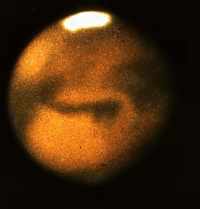
Martian exploration really began when telescopes became good enough for people to see detail on Mars. To start with, all that could be seen were fuzzy patches of dark and light brown-orange. As telescopes improved, it became obvious that Mars had ice caps. The idea that Mars was like Earth, with vegetation and a population soon became common. The dark and light patches were seen to alter with the seasons - and this supported the idea of vegetation. In fact it was only dust being blown back and forth. People's imagination ran wild, with little evidence to support any of the ideas that were being proposed. Even the astronomers of the time were responsible for feeding the myths of Martian civilisation in the late nineteenth century. The Martian canals saga is well known and an object lesson in misleading speculation.
Mars remained little more than an enigmatic orange blob until well into the twentieth century, when spacecraft from Earth were sent to investigate it. The United States of America and the Soviet Union both sent a series of probes to Mars in the decades of the nineteen-sixties and seventies.
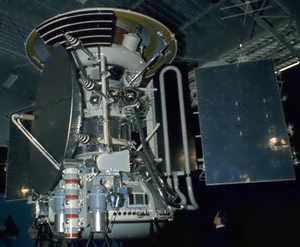 While the USSR had great success with Venus probes, they had little with Mars. Almost all their Mars missions failed. It was left to the USA and its space agency, NASA, to reveal Mars close up. This image is of a mock-up of the Soviet Mars 4 spacecraft at the 1968 Paris Airshow (left), which sadly failed. © Image: J W Hodges While the USSR had great success with Venus probes, they had little with Mars. Almost all their Mars missions failed. It was left to the USA and its space agency, NASA, to reveal Mars close up. This image is of a mock-up of the Soviet Mars 4 spacecraft at the 1968 Paris Airshow (left), which sadly failed. © Image: J W Hodges
Hopes were always high that life would be found, and some even thought that intelligent life would exist! This myth had been built up by Percival Lowell and Schiaparelli in the1890's, when the idea of the canals was in vogue. These subsequently proved to be optical illusions - the result of poor telescope optics, the shortcomings of the human eye, a vivid imagination and an ignorant press! It is incredible to think that the idea of canals was so ingrained that NASA's artist's impression of the Mariner spacecraft in the 1960's still showed Mars in the background, criss-crossed with canals!
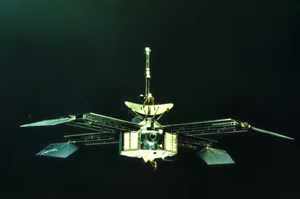
Mariner 4 (left) returned the first pictures - 21 in all - from a distance; but in 1969, it was Mariner 6 (below) that took the first close-ups from only 3400 km up as it flashed past. This caused something of a crisis at NASA , as it showed a sterile, sandblown and cratered world, on which there was little probability of life existing. Why would the public be interested in funding exploration of this place? Dreams were shattered, people were disappointed.
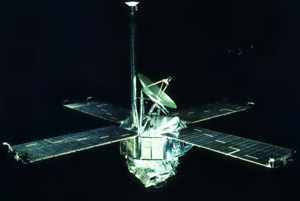
Mariner 9 became the first spacecraft to orbit another planet. That was in 1971. This brought renewed hope to NASA, for Mars was seen to be more interesting than first thought - volcanoes, enormous rift valleys, vast flood plains. Water, or some liquid had definately flowed across this planet! But when? Where was it now? Had it lasted long enough for life to have got started? This was good news and it spurred on the follow-up programme - Viking - which was the first soft-lander mission.
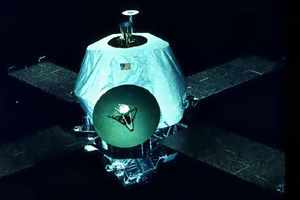
By now NASA had confidence in both its launchers and its spacecraft design. They were getting almost a 100% success rate. Still, just to be sure they always budgetted for, and launched, two craft. Fortunately for the Vikings, and the Pioneer and Voyager missions to the outer planets, all pairs performed as required and the data they returned were literally incredible! They changed the way we understand Planet Earth and the Solar System, and perhaps how we see our place in the Universe.
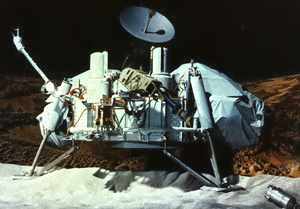
Vikings 1 and 2 landed in 1976, and became milestones in our understanding of the inner Solar System and Mars itself. This image (left) shows a mock-up of the lander.
For nearly 20 years, as NASA struggled with budget cuts and cost escalation associated with the Shuttle, Mars was left in relative peace. Only the Russians tried to visit and failed, with the Phobos probe and later, Mars 96.
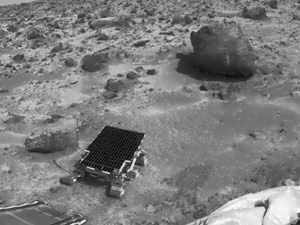
NASA had ambitions, though, for a major programme of discovery was being planned. This focused on the search for life and a plan for a "Sample Return Mission" to bring back Martian specimens. Ten missions were planned under the title of The Mars Surveyor Program. This started in 1996 with the launch of Pathfinder. The project is being undertaken in collaboration with missions of other nations including those of Europe (through ESA), Russia/Ukraine and Japan.
In the summer of 1997 a new era of Martian exploration really began. Pathfinder touched down on 4th July 1997, and let loose the first American robot rover, Sojourner. The mission was a spectacular success. Thousands of pictures were returned, detailed records of the Martian weather were made over a period of several months, and new information about Martian geology was discovered. This image shows the micro-robot, Sojourner leaving the Pathfinder Lander.
Close behind Pathfinder was Mars Global Surveyor. This is an orbiting spacecraft which collects data on the atmosphere, climate, geology, magnetosphere and gravity. Most spectacular, though, are the images that the spacecraft is sending back. These show details on the surface as small as one metre (3 feet). The result is that we now have better mapping data for the surface of Mars than we do for the Earth!
Surveyor 98 consists of two spacecraft, launched at different times and undertaking different tasks. Mars Climate Orbiter was launched in December 1998, with arrival at Mars on 23rd September, 1999. Mars Polar Lander was launched in January 1999, with a touchdown date of 3rd December, 1999. Another robot rover mission is planned, with Surveyor 2001 and further, more ambitious missions, will follow including Surveyor 2005.
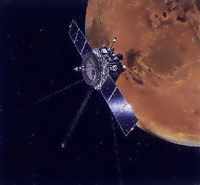
The Japanese space agency NASDA launched its orbiter in1998, Planet-B, which is now named Nozomi. It will be the first Japanese spacecraft to orbit Mars and was launched on July 4, 1998. It will arrive at Mars in 2004. Nozomi is a development vehicle, but will study the Martian atmosphere and its relationship with the solar wind. © Image: NASDA
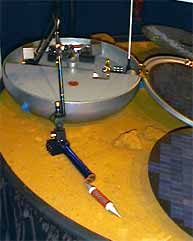 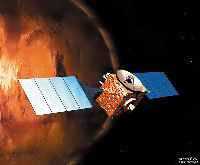
© Image(left): JW Hodges © Image(right): ESA
In 2003, the European Space Agency is planning to send Mars Express, which will carry a lander, Beagle 2. This is being developed by a consortium lead by the Open University in the UK, and supported by other British universities and industry. The mission of this spacecraft is specifically to look the chemical evidence of past life on Mars and it is named after Charles Darwin's ship, HMS Beagle, for this reason. This full-size model (left) was shown the Paris Airshow and the Royal Society in London in June 1999.

Return to rover
|













